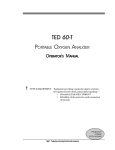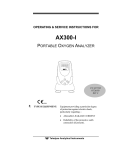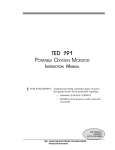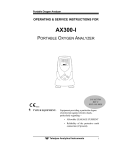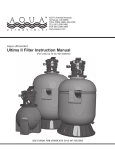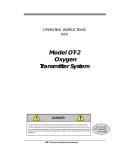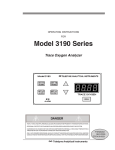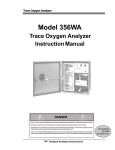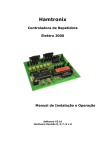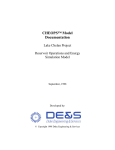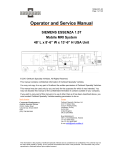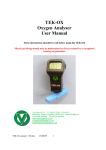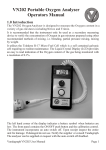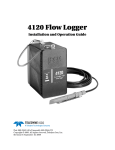Download TED 200-T - Teledyne Analytical Instruments
Transcript
INSTRUCTIONMANUAL TED200-T PORTABLE OXYGEN MONITOR TYPE B EQUIPMENT: Equipment providing a particular degree of protection against electric shock, particularly regarding— • allowable LEAKAGE CURRENT • Reliability of the protective earth connection (if present). P/N MC41901.02 04/09/99 ECO #99-0159 Teledyne Analytical Instruments i Copyright © 1999 Teledyne Electronic Technologies All Rights Reserved No part of this manual may be reproduced, transmitted, transcribed, stored in a retrieval system, or translated into any other language or computer language in whole or in part, in any form or by any means, whether it be electronic, mechanical, optical, manual, or otherwise, without prior written consent of Teledyne Electronic Technologies, 16830 Chestnut Street, City of Industry, CA 91749–1580 FCC Statement This equipment generates and uses radio frequency energy, and if not installed and used in strict accordance with the manufacturer's instruction manual, may cause interference to radio and TV communications. It has been type-tested and certified to comply with the limits for a Class A, and exceeds limits for a Class B, computing device pursuant to Subpart J of FCC Rules, which are designed to provide reasonable protection against such interference when installed in a commercial and residential environment. Operation of this equipment in a residential area may cause interference, in which case the user, at his own expense, will be required to take whatever measures may be required to correct the interference. Note: The above statement is required by the FCC for any device that incorporates microprocessors. NOTE: ii This analyzer has been evaluated according to ISO 7767 1997 Non compliances to this standard exist in relation to the requirements for Alarm frequency, audibility, maximum silence period, and low alarm threshold minimum level. Teledyne Analytical Instruments Warranty Teledyne warrants that the goods are free from defects of material and of construction for a period of 2 years from the date of shipment from Teledyne. The Class T-7 MicroFuel Cell is warranted for one year from the date of shipment from Teledyne. The liability of Teledyne, if any, shall be limited solely to the replacement and repair of the goods and shall not include shipping costs or other incidental damages as defined in Section 2-715 of the U.S. Uniform Commercial Code. This warranty is null and void if any goods are subjected to misuse, negligence, accident, or repairs other than those performed by Teledyne or an authorized service center. CAUTION: Federal law restricts this device to sale by or on the order of a physician. RFI/EMI Immunity The Teledyne Model TED 200-T has been tested to the standard required by the European Community for CE marking, EN 60601-1-2. The sample subjected to testing passed all sections of this testing with the exception of the following: From 26MHz to 250MHz, the display was unstable. When interference was removed, the equipment under test recovered. From 250MHz to 1000MHz, the display was stable. Teledyne Analytical Instruments iii Table of Contents 1 Introduction 1.1 Applications ...................................................................................... 1-1 1.2 Theory of Operation .......................................................................... 1-2 1.2.1 Sensor ..................................................................................... 1-2 1.2.2 Signal Processing .................................................................... 1-3 2 Operations 2.1 Setup ................................................................................................. 2-1 2.1.1 Battery Installation or Replacement ........................................ 2-2 2.1.2 Sensor Installation or Replacement ......................................... 2-3 2.1.3 Calibration ............................................................................... 2-4 2.1.4 Alarms ..................................................................................... 2-5 2.2 Use .................................................................................................... 2-6 2.2.1 Procedure ................................................................................ 2-6 2.2.2 Anesthetic Gases ..................................................................... 2-7 2.2.2.1 Gasses That Induce Reading Error ..................................... 2-7 2.2.2.2 Care After Use in Nitrous Oxide......................................... 2-8 2.2.3 Sterilization ............................................................................. 2-8 2.3 Do's & Don'ts .................................................................................... 2-9 3 Maintenance and Troubleshooting 3.1 TED 200-T Overall Maintenance ..................................................... 3-1 3.2 Battery Maintenance ......................................................................... 3-1 3.3 Sensor ............................................................................................... 3-2 3.4 Troubleshooting ................................................................................ 3-2 Appendices A.1 Specifications .................................................................................... A-1 A.2 Spare Parts List ................................................................................. A-1 A.3 Optional Accessories ......................................................................... A-2 A.4 Repair Service ................................................................................... A-3 A.5 Environmental Effects ....................................................................... A-3 A.5.1 Pressure .................................................................................. A-4 A.5.2 Humidity ................................................................................. A-4 A.5.3 Temperature ........................................................................... A-5 A.5.4 Discrepancy in Readings ........................................................ A-5 A.6 Material Safety Data Sheet ............................................................... A-6 iv Teledyne Analytical Instruments About This Manual The TED 200-T Operator's Manual provides both introductory and detailed information for installing and operating the monitor. The manual takes you from the time you unpack the box until you complete the first normal operating sample gas analysis. The bulk of the manual contains operating procedures and information. There are also cautions, warnings, and guidelines to ensure that your monitor operates normally and to its full potential. A complete product specifications and spare parts list is also included as an appendix. Chapter 1: An introduction to the monitor and its components, features and applications. Chapter 2: Step-by-step set-up procedures and information. Chapter 3: A guide for daily operational maintenance and troubleshooting. Appendix: Specifications and available spare part options for the monitor, and detailed application considerations to aid in troubleshooting, etc. How To Use This Manual This manual is designed to walk you through the initial set-up of the TED 200-T. After you have used it to initially install your monitor, it becomes a quick reference guide to help you with specific questions or operating problems. Before you even turn on the monitor, you are advised to read Chapters 1 and 2. These chapters help you to become better acquainted with the monitor and how it works before you actually begin to use it. Please read Chapter 2: Operations in its entirety before proceeding further with the manual. Teledyne Analytical Instruments v vi Teledyne Analytical Instruments Introduction 1 Introduction The Teledyne Electronics Technologies 200-T Portable Oxygen Monitor is an easy-to-use, portable instrument that provides fast and accurate oxygen monitoring and audio/visual alarm capability. The TED 200-T is designed to monitor up to 100 % oxygen concentration in medical gas mixtures. Because it is microprocessor-based, the TED 200-T has a unique combination of features and is very easy to use through a touch panel designed for minimal operator interface. Figure 1: Front view of the TED 200-T 1.1 Applications The TED 200-T is designed to be used for monitoring oxygen concentrations in a variety of medical gas mixtures. This instrument should never be used as a primary monitoring device. It is recommended that the instrument only be used as a secondary measuring device to verify the concentration of oxygen in gas mixtures prepared using a gas blender, anesthesia gas machine, or similar apparatus. Teledyne Analytical Instruments 1-1 1 Introduction The monitor may be used for verifying oxygen concentrations in gas mixtures used in: • Anesthesia • Respiratory Therapy • Neonatal Care. 1.2 Theory of Operation The TED 200-T can be divided into two major functional groups: • the T-7 Sensor and • Signal Processing. The analyzer uses Teledyne Electronics Technologies Class T-7 oxygen sensor. The current output from the sensor is fed into the electronic signal processor, where it is used to calculate the oxygen gas concentration and display it on the LCD screen. The data from the sensor is compared to values set by the user, and sets off the alarms if it exceeds those values. 1.2.1 Sensor The T-7 oxygen sensor is a galvanic cell that is made up of a cathode and anode immersed in electrolyte and packaged in a small plastic container. Oxygen entering the sensor stimulates a proportional amount of electrical current between the anode, cathode and electrolyte. This current is sent to the microprocessor, which measures and displays it as a percentage on the LCD screen, and then compares it to the alarm standards set by the user. If it exceeds alarm limits, the alarms are triggered. CAUTION: The electrolyte used in the T-7 sensor is caustic. Do not try to open the sensor assembly. Check the sensor regularly for leaks. If the sensor is leaking, discard of it in a safe manner. Do not try to repair it. Consult the Material Safety Data Sheet in the Appendix for handling guidelines. Attached to the T-7 sensor is a removable plastic diverter. This diverter is used to facilitate the transport of gas mixtures through the sensor. The diverter, packaged separately when shipped, is necessary when the tee adapter is used to sample gas flowing through a tube. The diverter is not necessary and should not be used when the sensor is placed directly in a chamber, or when the sensor is used in confined volume monitoring, such as incubators and inhalation tents. 1-2 Teledyne Analytical Instruments Introduction 1 CAUTION: Remove and save the diverter when the sensor is used in confined volume applications. 1.2.2 Signal Processing The electrical current developed in the sensor is sent to the microprocessor for processing. Processing includes amplification, conversion to digits, and comparison to alarm standards. Using a microprocessor allows for easier setting of alarms, automatic calibration, and self-diagnosis. When the battery runs low or the unit needs recalibration, the TED 200-T tells you so. The oxygen level is calculated and then displayed on the liquid crystal display (LCD) on the front panel. User-programmed high and low alarm setpoints are stored in random access memory (RAM) which resides within the microprocessor. The oxygen level calculated by the microprocessor is compared to these setpoints , and an alarm activated, if necessary. The audio alarm itself can be manually bypassed for a set amount of time by the user. Pressing the ALARM SILENCE key will stop the alarm in increments of 30, 90, and 180 seconds. The alarm can also be turned back on after silencing. Teledyne Analytical Instruments 1-3 1 Introduction 1-4 Teledyne Analytical Instruments Operations 2 Operations Note: Upon receipt, INSPECT THE ENTIRE UNIT FOR DAMAGE. Check the unit and all included accessories for broken or loose parts. If damaged, DO NOT USE. Notify the shipper, and consult Teledyne Electronic Technologies, Sensor Technologies. Note: This equipment is internally powered. 2.1 Setup The TED 200-T is suitable for use in many medical applications. The unit can be used on a table top or mounted on a pole using a mounting bracket (P/N B34102). To set up and use your TED 200-T: 1. Install the batteries. 2. Install the sensor. 3. Calibrate the unit. 4. Set the alarms. The front display touch panel is designed to insure that accidental touching or bumping of the panel will not reset any calibrations or settings. Each button used in a sequence must be pressed within five seconds of each other, and the CAL, ALARM TEST and OFF keys must be pressed twice in order to activate them. The ON/OFF key needs to be pressed once in order to turn on the TED 200-T, but must be pressed twice to turn it off. Teledyne Analytical Instruments 2-1 2 Operations Sensor cable receptacle Battery compartment Figure 2: TED 200-T rear view 2.1.1 Battery Installation or Replacement Note: Four “AA” alkaline batteries must be installed in the unit before the TED 200-T will operate. Each time new batteries are installed, the display will flash AIR CAL. The HI alarm will read 100%; the LO alarm will read 17%. The oxygen value will be blank until the unit is calibrated in air. Note: When new batteries are installed, typically, the unit is suitable for use immediately after installation. 1. Turn the unit off (if it is on). 2. Open the battery compartment. Door swings open left to right. 3. Remove the battery holder and take out batteries, if any. CAUTION: Improper installation of the batteries may result in heat damage to the batteries. Note: Use alkaline batteries only. Other types will give erroneous battery test readings. 4. Install 4 “AA” alkaline batteries into the holder. Each battery has its own slot. To insure proper polarity, place the bottom (flat) or negative end of the battery in the end of the holder marked “–” (the end with the spring). Place the top (button) or positive end of the battery in the end of the holder marked “+”. Do this for each battery. 5. Snap the battery holder onto the red and black wired snap connector and slide the battery holder into the compartment. Be careful not to pinch the wires. The holder should seat firmly in the compartment. 2-2 Teledyne Analytical Instruments Operations 2 6. Close the compartment door. The front panel will now display HI ALARM 100 and LO ALARM 17 with a flashing AIR CAL. 7. To test the batteries after the unit has been calibrated: Press the BATT TEST key once. The display should show BATTERY HRS LEFT as 999. 2.1.2 Sensor Installation or Replacement Note: The T-7 oxygen sensor must be installed before the TED 200-T can be operated. For sterilization procedures, see page 2.8: Sterilization. Note: When a new sensor is installed, typically, the unit is suitable for use immediately after installation. CAUTION: Do not autoclave the sensor. 1. Remove the new sensor from its protective bag. Inspect the sensor for damage or electrolyte leakage. If the sensor is damaged, obtain a replacement. Do not use the defective sensor as it may damage the unit. WARNING: THE SENSOR ELECTROLYTE IS CAUSTIC. DO NOT LET IT COME IN CONTACT WITH SKIN. IF IT DOES, FLUSH AFFECTED AREA WITH WATER. DO NOT ATTEMPT TO OPEN OR REPAIR THE SENSOR. LEAKING OR EXHAUSTED SENSORS SHOULD BE DISPOSED OF IN ACCORDANCE WITH LOCAL REGULATIONS. CONSULT THE MATERIAL SAFETY DATA SHEET IN THE APPENDIX. Figure 3: Mounting the sensor in the tee adapter Teledyne Analytical Instruments 2-3 2 Operations HI & LO alarm settings Battery test key HI alarm set key ON/OFF key Up key Red LED alarm LCD display LO alarm set key Alarm silence key Alarm test key Down key Calibration key Figure 4: TED 200-T front touch panel 2. Plug one end of the coiled cable into the telephone jack receptacle on the end of the T-7 sensor. The jack will only fit one way, so if it will not fit, rotate it until it slides in easily. 3. Plug the other end of the coiled cable into the receptacle located on the righthand side panel of the TED 200-T. This jack will only fit one way, so do not force it. Note: If the TED 200-T is used for diffusion sampling (i.e., incubators, tents, etc.), the plastic flow diverter must be removed from the T-7 sensor. If the sensor is used in breathing circuits, etc, the diverter must be used as shown in Figure 3. 2.1.3 Calibration After installation of the batteries the display will show HI ALARM 100 and LO ALARM 17, an AIR CAL message will flash, and the oxygen reading will be blank. An air calibration must be performed before an oxygen reading will display. 1. For first time and routine maintenance calibrations, make sure that the sensor and sensor cable have been installed correctly and that the sensor is in room air uncontaminated with excess oxygen or other gases. For routine calibrations, set the LO and HI alarm limits to 17 and OFF, respectively. 2-4 Teledyne Analytical Instruments Operations 2 2. If calibrating for the first time, press the CAL key once. After initial calibration, press the CAL key twice. CAUTION: It is very important that air (21 % oxygen) calibration be performed every time the batteries are disconnected or replaced in the TED 200-T. The microprocessor cannot perform its task properly without this data. After 10 seconds a reading of 20–22% oxygen will be displayed. CAL IN 100% will flash for a period of 5 seconds, during which time the reading of 20–22 will continue. This is a reminder that a 100% oxygen calibration should be performed to achieve maximum accuracy. Note: When calibrating in 100 % oxygen, it is recommended that the plastic flow diverter and tee adapter be installed into a flowing circuit with pure dry oxygen flowing past the sensor assembly. An accessory calibration assembly (P/N C53790) is available from TET Sensor Technologies for use where breathing circuits are not normally used. 3. Place the sensor in 100% oxygen (place the sensor in a small plastic bag and flush with pure, dry oxygen) and allow the reading to stabilize. Wait until the reading is stable for at least 10 seconds. If the reading is other than 100, press the CAL key twice. After 15 seconds a reading of 99–101 will display. Note: For the specified accuracy in monitoring any oxygen level above 30–40%, a 100% calibration must be performed after the 21% (air) calibration. DO NOT calibrate in air subsequent to the 100% calibration, as calibrating in air again will cancel the previous 100% calibration. The 100% calibration may be repeated as many times as desired without affecting the air calibration. It is important to perform the calibration carefully and thoroughly, making certain that uncontaminated calibration gases are used and that stable readings are achieved before the calibration is locked in. The accuracy achievable by the monitor is only as good as the procedure used to calibrate it. Note: Never calibrate the unit in humidified gas, as water vapor makes the oxygen concentration appear lower than it really is. See Appendix: Humidity. 2.1.4 Alarms 1. To set the HI alarm: Press the SET HI ALARM key once. Within 5 seconds, press the yellow UP or DOWN arrow keys until the screen displays the desired value. Teledyne Analytical Instruments 2-5 2 Operations NOTE:The HI alarm may be defeated by setting the limit one step above 100%. The display will show HI ALARM OFF and flash ALARM DEFEATED. 2. To set the LO alarm: Press the SET LO ALARM key once. Within 5 seconds, use the yellow UP and DOWN arrow keys to select a value. A safety feature will not allow you to select a LO alarm value less than 17. NOTE:The TED 200-T is designed to prevent crossing of HI/LO alarm settings. If you try to make the LO alarm higher than the HI alarm, it will push the HI alarm setting up as you continue to raise the LO alarm setpoint. This also applies when attempting to set the HI alarm lower than the LO alarm. 3. To test the alarms, press the ALARM TEST key twice. The display will show ALARM TEST. The oxygen reading on the display will sequence to the HI alarm value and activate the audible/visible alarm for 1-2 seconds. It will then sequence down to the LO alarm value and activate the audible/ visible alarm for 1-2 seconds. 4. To override the audible alarm, press the ALARM SILENCE key: • once for 30 seconds of silence; • • • twice for 90 seconds of silence; three times for 180 seconds of silence; four times to discontinue the override. The display will flash ALARM SILENCE and then count down the remaining alarm silence time. The unit will continue monitoring and displaying the oxygen concentration. NOTE: The accuracy of the alarm Set Points of the TED 200 is the same as that of the O2 reading as these are both derived mathematically from the A/D converter reading. NOTE: It is highly suggested not to set low alarm below 18%. 2.2 Use 2.2.1 Procedure Note: Prior to use, always test the batteries and alarms; check calibration, the sensor for leaks and damage, and the alarm settings. The TED 200-T can be used to monitor gas mixtures for oxygen in two basic modes: 1. In breathing circuits or other instances where gases are flowing in tubing circuits. 2. In confined volumes such as incubators or tents. 2-6 Teledyne Analytical Instruments Operations 2 When monitoring for oxygen in breathing circuits, the diverter must be used. The diverter should be screwed onto the threaded front end of the T-7 sensor. A tee adapter (either plastic, P/N A268, or metal, P/N A283) should be placed into the circuit, and the above sensor assembly plugged into the tee adapter. CAUTION: Check the breathing circuit for leaks. Be certain that the circuit downstream of the sensor does not produce any back-pressure or restriction to flow, or errors in readings will result. When monitoring for oxygen in confined volumes such as incubators, hoods, etc., the flow diverter must be removed from the T-7 sensor so that it does not interfere with the rapid exchange of gases to and from the sensing surface of the T-7. CAUTION: Failure to remove the diverter in these application areas will result in a marked lowering of the response time of the sensor. The T-7 sensor can be placed or hung inside incubators, tents, etc. When it is necessary to thread the cable through a small hole in order to gain access to the inside of a chamber, the cable should be disconnected at the sensor, threaded through the hole, and reconnected inside the chamber. A calibration check may be conducted at any time to assure proper operation. Remove the diverter and expose the sensor to room air, and verify that the reading is 20–22%. Expose the sensor to 100% oxygen (preferably using the diverter and tee adapter in a flowing circuit) and verify that the reading is 99–101%. 2.2.2 Anesthetic Gases 2.2.2.1 Gases that induce reading error When using the T-7 sensor in the presence of anesthetic gases such as Halothane, the oxygen reading may fall (see the table below). The magnitude of this error will depend upon the level of oxygen and the duration of exposure. The anesthetic agents listed in the following table (Halothane, Enflurane, Isoflurane, Sevoflurane, and Desflurane) were vaporized into a stream of 30% oxygen/ 70% nitrous oxide, and the resulting drops in oxygen level after an exposure of approximately two hours were noted. Exposures in excess of two hours will produce slightly greater error. The errors listed are typical for all oxygen sensors such as the T-7. Exposing the sensor to air or gases that do not contain anesthetic agents for a period of time equal to or greater than the exposure interval will eliminate the reading error in most cases. Teledyne Analytical Instruments 2-7 2 Operations Gas or Vapor Level (Balance: Mixture of 30% O2 / 70% N20, except where noted) Gas or Vapor Helium Nitrous Oxide Carbon Dioxide Halothane Enflurane Isoflurane Sevoflurane Desflurane Test Level 50%, balance O2 80%, balance O2 10%, balance O2 4% 5% 5% 5% 15% Oxygen Reading Error * 0% 0% 0% < -1.5% O2 < -1.5% O2 < -1.5% O2 < -1.5% O2 < -1.5% O2 * Errors are approximate and may vary based on exposure times and concentrations. These performances meet or exceed the requirements of ISO 7767: 1997 (E). CAUTION: The TED 200-T should not be used in the presence of flammable anesthetics such as diethyl ether or cyclopropane. 2.2.2.2 Care after use in nitrous oxide CAUTION: The T-7 sensor should not be left in nitrous oxide mixtures any longer than absolutely necessary. After exposure to nitrous oxide mixtures, the sensor should be left in 100% oxygen overnight (e.g., left in a breathing circuit that has been flushed with pure oxygen). If this is not practical, the plastic flow diverter should be removed and the sensor left in room air. If the oxygen reading continues to drop after each use in nitrous oxide the sensor should be removed from service. If the sensor can no longer be calibrated or if there is any sign of electrolyte leakage, the sensor should be disposed of in accordance with local regulations and the Material Safety Data Sheet (MSDS) located in Chapter 4.0: Appendices. 2.2.3 Sterilization The T-7 sensor and interconnecting cable may be gas sterilized using low temperature ethylene oxide. A vacuum must not be drawn on the sensor during the sterilization process. The TED 200-T itself cannot be liquid sterilized or autoclaved. The surface of the case may be wiped with isopropyl alcohol and allowed to air dry. In extreme cases, a mild detergent may be used. 2-8 Teledyne Analytical Instruments Operations 2 2.3 Do’s and Don’ts – DO – • • • • • • • • • • • • • • • Read all of the directions before using for the first time. Calibrate every 8 hours or before every use. Visually inspect the sensor for leakage before each use. Use 2-point calibration every time: 21%, then 100%. Check the HI and LO alarm settings prior to each use. Test batteries regularly (replace immediately when indicated). Keep the unit, sensor and connections dry, or on the dry side of the breathing circuit. Recalibrate after replacing the batteries. Recalibrate after replacing the sensor. Use properly installed alkaline batteries only. Make sure the T-7 sensor is properly attached. Use the plastic flow diverter only when using the tee adapter. Remove and save the plastic flow diverter when using the unit in chamber applications (incubators, tents, etc.) Perform an alarm test before each use (press the ALARM TEST key twice). Clean the case with isopropyl alcohol or mild detergent only. – DON’T – • • • • • • • • • • • • Use the TED 200-T if you suspect any malfunction. Use the TED 200-T in the presence of flammable gases. Use anything but alkaline batteries. Autoclave or freeze the T-7 sensor or TED 200-T unit. Open or try to repair a leaking or broken sensor. Immerse the unit or sensor in any liquid. Pass hot or cold gas mixtures over the sensor. Expose the unit to devices that produce high levels of radio, short wave, microwave, x-ray, or high frequency interference. Use cleaning agents or liquids in the cable receptacles or around the battery compartment. Place the TED 200-T unit itself in a water vapor-saturated environment. Expose the LCD to excessive sunlight. Expose the TED 200-T to a condensing water environment such as a mist tent. Teledyne Analytical Instruments 2-9 2 Operations 2-10 Teledyne Analytical Instruments Maintenance and Troubleshooting 3 Maintenance and Troubleshooting 3.1 TED 200-T Overall Maintenance The TED 200-T unit itself requires very little maintenance, other than calibration, checking and changing the batteries and sensor, and cleaning the plastic housing, which can be done with isopropyl alcohol. Should any part of the instrument malfunction or fail to perform, the unit should be removed from service. The unit is not user-serviceable. 3.2 Battery Maintenance DO: Test batteries regularly (replace immediately when indicated). DO: Always use alkaline batteries. DO: Recalibrate after replacing batteries. To test the batteries, press the BATT TEST button once. The display will show BATTERY HOURS LEFT (to a maximum of 999 hours) of remaining battery life. This value is only a guide. Excessive alarm activation will wear down the battery faster than usual. Should the remaining battery life reach 24 hours, the alarms will activate and the screen will display LOW BATTERY. Note: The TED 200-T is designed to automatically check its battery life once per hour. When setting the HI/LO alarms or checking the batteries, the unit will freeze the oxygen reading momentarily. The minimum detectable change in battery voltage corresponds to an increment of about 50 hours, meaning that the battery voltage reading may not change for several hours at a time. When the battery voltage becomes low, a LOW BATTERY message will flash on the display until the batteries are replaced. If there are only 24 hours remaining and the batteries are not replaced, the screen will blank except for a LOW BATTERY message. The unit will beep and flash continuously. Teledyne Analytical Instruments 3-1 3 Maintenance and Troubleshooting If the unit is left on after this, the LCD display will eventually shut down, the red LED will stay lit, and the beeper will emit a continuous tone. If the batteries are still not replaced, the LED and beeper will drain the remaining power and go completely dead. If the TED 200-T will not be used for a period of 30 days or more, the batteries should be removed prior to storage. To replace batteries, see chapter 2, section 2.1.1. Remember, the unit must be calibrated after the batteries are replaced. 3.3 Sensor Maintenance DO: check the sensor for damage or leaks before use. DO: recalibrate after replacing the sensor. DON’T: immerse the T-7 sensor in liquid. DON’T: autoclave the T-7 sensor. DON’T: open or try to repair the sensor. Before every use, the sensor, cable and connections should be checked. Check the sensor for leaks and condensation. Check the cable for splitting or cracked insulation. Make sure the connections are tight and dry. In the event that the sensor has been damaged, consult the Material Safety Data Sheet in the Appendix for handling guidelines. To replace the sensor, see chapter 2, section 2.1.2. 3.4 Troubleshooting The TED 200-T provides a variety of built-in safety features which prevent instrument use when a fault or incorrect calibration procedure is detected. When a unit repeatedly displays the messages REPLACE SENSOR or SEE TROUBLESHOOT, sounds/flashes the alarms continuously, or refuses to turn on, it may be an indication of an erroneous calibration, an intermittent or faulty connection, an expired sensor, or a low battery. To determine where the difficulty lies, refer to the following guidelines. NOTE: The TED 200T Service Manual (P/N SMC41901.02) is available from the factory and contains circuit diagrams, test procedures and other information which will assist qualified technical personnel in repairing the Monitor. 3-2 Teledyne Analytical Instruments Maintenance and Troubleshooting 3 Symptom Why What to Do A new sensor will not calibrate in air. The TED 200-T display flashes REPLACE SENSOR or SEE TROUBLESHOOT after a second attempt to calibrate. A new sensor must be allowed to stabilize prior to calibration. A) Wait 1–2 minutes and try again. B) Oxygen concentration at the sensor is significantly higher than 21%. Take the instrument to a well-ventilated area and repeat the calibration. C) Try calibrating a known good sensor; if this fails, see symptom "Reading drifts over 2–3%..." A) The sensor must be allowed to stabilize in 100% oxygen before calibration is attempted, or the oxygen concentration at the sensor is less than 100%. A) Wait 1–2 minutes or until the oxygen concentration reading is stable; push the CAL key twice; wait for calibration sequence to finish. B) Make sure that at least 12" (30 cm.) of tubing is attached to the exhaust side of the tee adapter to prevent backfilling. O2 flow rate should not exceed 5 l/min. C) Prevent dilution of gas with H2O vapor by removing humidifiers, nebulizers, etc. Check for leaks or open circuits. D) Repeat air calibration; be sure to allow enough time for all O2 to diffuse; remove plastic flow diverter. E) Repeat 100% calibration. F) Replace sensor. The unit successfully calibrates at 21%, but will not calibrate at 100%. The display is flashing REPLACE SENSOR or SEE TROUBLESHOOT. B) A stable low reading had not been achieved during air calibration. A) Remove T-7 sensor from tee adapter and unscrew the plastic flow diverter. Using absorbent tissue or cotton swab, gently wipe off sensing surface inside threaded portion of sensor assembly. B) Relocate unit away from sources of RFI. The TED 200-T does not react to changes in oxygen concentration, or the readings are unstable and drifting. Teledyne Analytical Instruments 3-3 3 Maintenance and Troubleshooting Symptom Why The oxygen reading fluctuates or appears to be incorrect. Like all O2 sensors, the T-7 detects the changes in the partial pressure of O2. See Appendix: Pressure. The unit appears to have a momentary or intermittent condition which causes the alarms to activate; unit cannot be silenced and all keys are not functioning. The TED 200-T is equipped with an electronic "watch dog," which monitors the circuitry within the unit for potential faults, and may activate the alarm and disable key functions. The "watch dog" can be reset only by disconnecting the batteries. Several conditions can activate the "watch dog." Dropping the unit, poor battery connections, and radio frequency interference are the most common causes. 3-4 Teledyne Analytical Instruments What to Do A) During calibration, make sure there are no restrictions on exhaust side of sensor. If the reading changes with flow, the sensor is pressurized or there may be a leak in the system. B) If a high degree of accuracy is desired, or the concentration of O2 is in excess of 40%, calibration with 100% is recommended. C) If humidified gas is used to ventilate the patient, water vapor actually dilutes the gas. See Appendix: Humidity, Temperature. D) If a blender is used, check its calibration. See Appendix: Discrepancy in Readings. A) Disconnect the batteries and inspect the contacts and wires for damage or corrosion. Bend the battery pack and connector contacts slightly, if necessary. Reconnect the batteries and calibrate the unit. If the unit appears to function properly, check the alarms and settings. If the alarm continues or the unit does not function, return the unit to Teledyne for repair. B) Replace batteries. C) Increase the distance between the unit and any sources of radio frequency interference. Relocate the sensor cable as conveniently as possible. Try different positions. Maintenance and Troubleshooting 3 Symptom Why What to Do Alarm sounds/flashes continually, but keys are functioning normally. A) Reading outside alarm limits. B) Sensor output low, activating internal safety system. A) Reset alarm levels. B) Remove excess condensate, recalibrate, or replace sensor. A) Batteries expired. B) Bad battery connection. C) Unit not calibrated after the batteries were reconnected. A) Check/replace batteries. B) Check battery connections. C) Calibrate. Unit reads 00 and alarms sound/flash continually. A) Sensor not plugged in. B) Sensor cable not plugged in or bad connection. A) Check and reconnect, then calibrate. B) Replace cable or sensor (depending upon location of bad connection). Reading drifts over 2–3% over a period of 3–4 hours. A) Intermittent cable connection. B) Intermittent sensor connection. A) Replace cable. No response when pushing a front touch panel button. All other functions appear normal. Some TED 200-T keypads require two successive strokes within a 5-second period for activation. See Chapter 1.0: Introduction or Chapter 2.0: Set-Up. No display. B) Replace sensor. NOTE: In the event that none of these procedures produce desired results, remove the batteries and return the unit to Teledyne for repair. Teledyne Analytical Instruments 3-5 3 Maintenance and Troubleshooting 3-6 Teledyne Analytical Instruments Appendices Appendices A.1 Specifications Range: Accuracy: Response Time: Display: Battery Life: 0-100% oxygen +2% of full scale (at constant temperature) 90% in less than 8 seconds (typically 6-8 seconds at 25 °C) Digital LCD with battery-life indication Approximately 1,000 hr. continuous use in a non-alarm condition System Power: 4 AA alkaline batteries. Sensor Type: Class T-7 System Enclosure: 7" W × 5" D × 2-1/2" H (178 mm × 127 mm × 63.5 mm) Weight: Less than 2 lb (Less than 1 kg) Cable Length: Retracted: 2 ft / Extended: 10 ft Storage Temp.: 10-30 °C continuous, 0-50 intermittent °C Operating Temp.: 0-40 °C Stability: Less than 1% O2 over an 8 hour period at constant pressure and temperature O2 level alarm ranges: Hi alarm: 18 to 100 Percent Low alarm: 17 to 100 percent O2 level alarm accuracy: Alarm thresholds digitally stored and alarm effectivity is digitally compared against the value calculated by the microprocessor. Hence, the accuracy of the alarms is the same as the accuracy of the unit as specified above. Warm up time: Typically 20 minutes or less A.2 Spare Parts List QTY 1 4 PART NO. DESCRIPTION A51327 B99 Micro-Fuel Cell T-7 with flow diverter P/N A50057 “AA” size alkaline battery Teledyne Analytical Instruments A-1 Appendices 1 1 1 B384 C885 A268 Battery holder Cable assembly Tee adapter (22 mm) A.3 Optional Accessories 1 1 1 1 1 1 1 B34102 A51589 A51588 C53790 A284 A274 A283 Mounting clamp T-7 adapter cap, female (22 mm) T-7 adapter cap, male (22 mm) Calibration assembly Universal adapter set for pediatric circuits (15mm) Tee adapter, autoclavable Tee adapter, metal Schematics are available on request. A minimum charge is applicable to spare parts orders. Note: Orders for replacement parts should include the model number, serial number, and range of the analyzer for which the parts are intended. ORDERS SHOULD BE SENT TO: TELEDYNE ELECTRONIC TECHNOLOGIES Sensor Technologies 16830 Chestnut Street City of Industry, CA 91749-1580 TELEPHONE: (888) 789-8168 (626) 934-1500 (626) 961-9221 FAX: (626) 961-2538 (626) 934-1651 TECHNICAL SUPPORT: (626) 934-1673 TWX (910) 584-1887 TDYANLY COID or your local representative. A-2 Teledyne Analytical Instruments Appendices A.4 Repair Service PLEASE READ CAREFULLY In the event that your TED 200-T Portable Oxygen Monitor needs servicing, the following steps will help to ensure that the repair request is processed promptly. Contact your authorized TET Sensor Technologies distributor or factory for return instructions. Do not ship your monitor without first obtaining authorization. Include a copy of the sales invoice or other proof of purchase date. Warranty service may be denied if no proof of purchase is included. It is your responsibility to pay shipping charges to Teledyne Electronic Technologies. If the unit is under warranty, the serviced or replaced monitor will be returned to you postage prepaid. NOTE: Either the TED 200T Oxygen Monitor and/or the T-7 Oxygen Sensor can be shipped using normal air and ground transportation. No special environmental conditions for transport and or storage are required. Monitors and sensors damaged by accident or misuse are not covered by the warranty. In these situations, service charges will based on time and materials. A.5 Environmnetal Effects A.5.1 Pressure Virtually all gas sensors and monitors measure the partial pressure, not the percentage, of the gas that they sense. The only time that these instruments can accurately read percentages is when the total pressure does not vary over time between calibration and use. This is why it is important to calibrate the TED 200-T oxygen sensor at regular intervals. It is recommended that the unit be calibrated prior to each use or every 8 hours. When the sensor is connected to a ventilator circuit, the alternating "breathing" pressure cycles generated by the ventilator will be sensed as an increase in the oxygen percentage (especially if the sensor is fast enough to sense the changes, as is the T-7). In reality, the percentage of oxygen in not changing; it is the total pressure that is increasing, producing a corresponding increase in the partial pressure of oxygen. A hundredcentimeter water pressure pulse will produce a .11 atmosphere, or an 11% increase in the total and therefore partial pressure of oxygen. Assuming that the sensor is fast enough to track this pressure pulse, an unpressurized reading of 50% oxygen will increase to 55.3% if the sensor is subjected to a pressure cycle of 100 cm H2O. The reading will rise proportionally less for smaller pressures. Teledyne Analytical Instruments A-3 Appendices A.5.2 Humidity Humidity does not directly affect the accuracy of the sensor's measurement. However, when a nebulizer or other device is used to increase moisture levels in gas mixtures, the moisture actually dilutes the mixture. This dilution effect decreases the oxygen concentration. For example, if an 80% oxygen gas mixture is humidified to saturation at room temperature, the resulting gas mixture will contain only 77.5% oxygen. Your TED 200T oxygen monitor accurately measures decreases in the oxygen concentration due to the dilution effects of moisture added to gas mixtures. As with all oxygen sensors, excessive condensation on the sensing surface of the T-7 will block the diffusion of oxygen to the sensor, rendering it inoperative. We recommend installing the sensor on the dry side of the breathing circuit at all times. Water condensate on the exposed cable contacts at the rear of the sensor may affect the oxygen reading and should be removed by shaking out the condensed water and allowing the sensor to air dry. A.5.3 Temperature The T-7 oxygen sensor adjusts for ambient temperature changes in the range of 0–40°C (32–106°F). Since the thermistor that compensates for these changes is located in the rear of the sensor assembly, it is important that gas mixtures, flowing over the front of the sensor, be at room temperature. Reading errors may occur if hot gases from a heated humidifier are directed past a sensor teed into a breathing circuit. A small thermal tracking error may be encountered in application areas where the entire sensor assembly is placed in the gas mixture to be analyzed (e.g., incubators). No adjustments should be made during this period (about 1 to 2 hours), since this error will be eliminated when both the thermistor and sensing electrode have had sufficient time to come to thermal equilibrium. A.5.4 Discrepancy in Readings The TED 200-T should never be used as a primary monitoring device. It is intended to be used as a secondary oxygen monitor, meaning that it is intended to verify the accuracy of and check the oxygen concentration leaving another oxygen mixing device or primary life support system (i.e., a blender or anesthesia machine). Whenever there is a significant difference in the oxygen readings between the primary and secondary monitors, the discrepancy must be resolved immediately. The information obtained from the TED 200-T should never be used to make adjustments to the primary lifesupport system, but should only be used as an indication that the primary device may require service and/or calibration. A-4 Teledyne Analytical Instruments Appendices The BATT TEST control of the TED 200-T immediately determines if the batteries need replacing. The TED 200-T should momentarily be removed from the application area and be checked for calibration and sensor integrity. If the TED 200–T can be calibrated, the unit can be assumed to be in good working order and capable of providing readings to specification. If, after reinstalling the TED 200-T, the discrepancy in oxygen readings persists, the problem is most likely elsewhere (i.e., flow blockage, primary device error, etc.). Further investigation should be made until the discrepancy in readings is resolved. If it is found that replacing the sensor and/or batteries does not give proper calibration results, the troubleshooting section of this manual should be consulted. NOTE: The MSDS on this material is available upon request through the Teledyne Environmental, Health and Safety Coordinator. Contact at (626) 934-1592 Teledyne Analytical Instruments A-5 Appendices A-6 Teledyne Analytical Instruments Appendices A.6 Material Safety Data Sheet Section I – Product Identification Product Name: Micro–Fuel Cells Mini–Micro–Fuel Cells, all classes Super Cells, all classes except T–5F Oxygen Sensors, all classes. Manufacturer: Address: Phone: Technical Support: Environment Health and Safety: Date Prepared : Teledyne Electronic Technologies/Analytical Instruments 16830 Chestnut Street, City of Industry, CA 91748 (626) 934-1500 (626) 934-1673 (626) 934-1592 08/26/98 Section II – Physical and Chemical Data Chemical and Common Names: Potassium Hydroxide (KOH), 15% (w/v) Lead (Pb), pure CAS Number: KOH 1310–58–3 Pb 7439–92–1 Melting Point/Range: Boiling Point/Range: Specific Gravity: pH: Solubility in Water: Percent Volatiles by Volume: Appearance and Odor: KOH -10 to 0 °C 100 to 115 °C 1.09 @ 20 °C >14 Completely soluble None Colorless, odorless solution Teledyne Analytical Instruments Pb 328 °C 1744 °C 11.34 N/A Insoluble N/A Grey metal, odorless A-7 Appendices Section III – Physical Hazards Potential for fire and explosion: The electrolyte in the Micro–Fuel Cells is not flammable. There are no fire or explosion hazards associated with Micro–Fuel Cells. Potential for reactivity: The sensors are stable under normal conditions of use. Avoid contact between the sensor electrolyte and strong acids. Section IV – Health Hazard Data Primary route of entry: Exposure limits: OSHA PEL: ACGIH TLV: Effects of overexposure Ingestion: Eye: Dermal: Inhalation: Signs/symptoms of exposure: Medical conditions aggravated by exposure: Carcinogenity: Other health hazards: A-8 Ingestion, eye/skin contact .05 mg/cu.m. (Pb) 2 mg/cu.m. (KOH) The electrolyte could be harmful or fatal if swallowed. Oral LD50 (RAT) = 3650 mg/kg The electrolyte is corrosive; eye contact could result in permanent loss of vision. The electrolyte is corrosive; skin contact could result in a chemical burn. Liquid inhalation is unlikely. Contact with skin or eyes will cause a burning sensation and/or feel soapy or slippery to touch. None NTP Annual Report on Carcinogens: Not listed LARC Monographs: Not listed OSHA: Not listed Lead is listed as a chemical known to the State of California to cause birth defects or other reproductive harm. Teledyne Analytical Instruments Appendices Section V – Emergency and First Aid Procedures Eye Contact: Skin Contact: Ingestion: Inhalation: Flush eyes with water for at least 15 minutes and get immediate medical attention. Wash affected area with plenty of water and remove contaminated clothing. If burning persists, seek medical attention. Give plenty of cold water. Do not induce vomiting. Seek medical attention. Do not administer liquids to an unconscious person. Liquid inhalation is unlikely. Section VI – Handling Information NOTE: The oxygen sensors are sealed, and under normal circumstances, the contents of the sensors do not present a health hazard. The following information is given as a guide in the event that a cell leaks. Protective clothing: Rubber gloves, chemical splash goggles. Clean-up procedures: Wipe down the area several times with a wet paper towel. Use a fresh towel each time. Protective measures during cell replacement:Before opening the bag containing the sensor cell, check the sensor cell for leakage. If the sensor cell leaks, do not open the bag. If there is liquid around the cell while in the instrument, put on gloves and eye protection before removing the cell. Disposal: Should be in accordance with all applicable state, local and federal regulations. NOTE: The above information is derived from the MSDS provided by the manufacturer. The information is believed to be correct but does not purport to be all inclusive and shall be used only as a guide. Teledyne Electronic Technologies shall not be held liable for any damage resulting from handling or from contact with the above product. Teledyne Analytical Instruments A-9



































